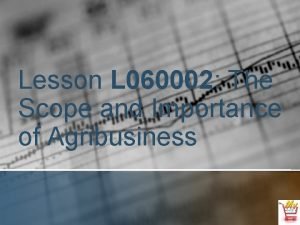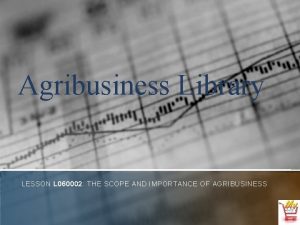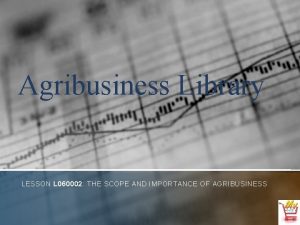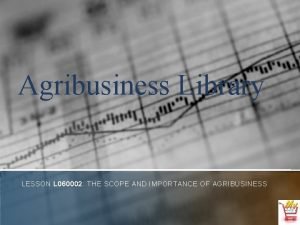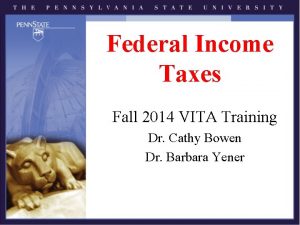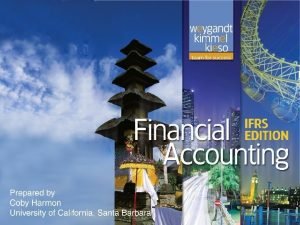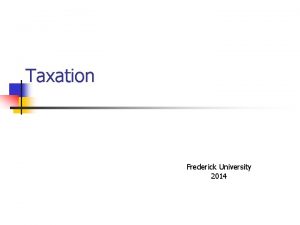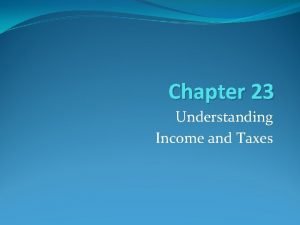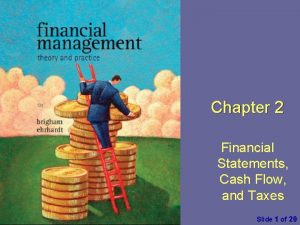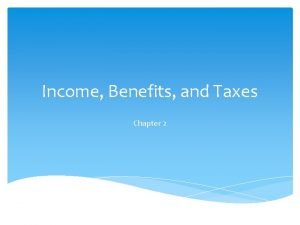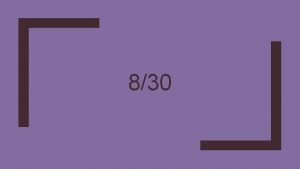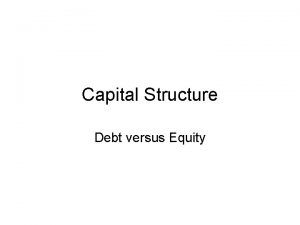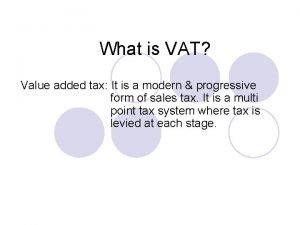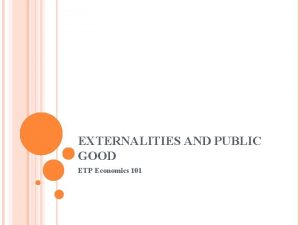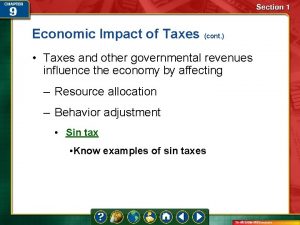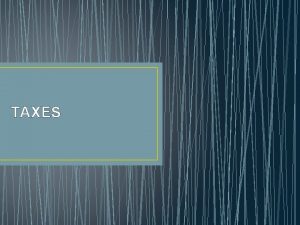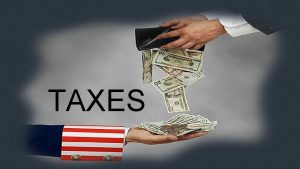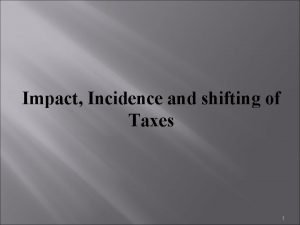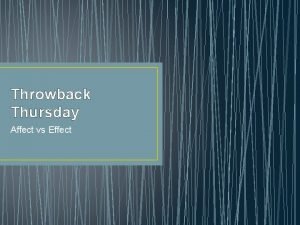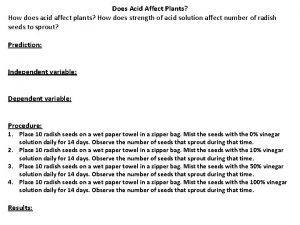Economic Impact of Taxes C 9 Taxes affect
























- Slides: 24

Economic Impact of Taxes C 9 • Taxes affect the factors of production and, therefore, resource allocation. • A tax placed on a good at the factory raises production costs (supply curve shifts to the left); if demand stays the same, the equilibrium price goes up. • Taxes affect the economy by encouraging or discouraging certain activities. • A sin tax is a high-percentage tax that raises revenue while reducing consumption of a socially undesirable product. • Taxes affect productivity and economic growth by changing the incentives to save, invest, and work. • The incidence of a tax is the final burden of the tax.

Criteria for Effective Taxes • Criterion 1: equity or fairness; taxes are considered fairer if they have fewer loopholes— exceptions, deductions, and exemptions. • Criterion 2: simplicity; tax laws should be easy to understand. • Criterion 3: efficiency, which means it is easy to administer and is successful at generating revenue.

Two Principles of Taxation • The benefit principle states that those who benefit from government goods and services should pay in proportion to the amount of benefits they receive. • The ability-to-pay principle is the belief that people should be taxed according to their ability to pay, regardless of the benefits they receive.

Types of Taxes • A proportional tax is one that imposes the same percentage on everyone, regardless of income. • A progressive tax is one that imposes a higher percentage of tax on persons with higher incomes. • A regressive tax is one that imposes a higher percentage on low incomes than on high incomes. • Marginal tax rate is the tax rate that applies to the next dollar of taxable income.

Interest Rate C 11 New C 12 Old • Two types of interest exists • Simple interest is figured only on the principle • Compound interest is paid on the principle plus any interest that has been earned. • Over time, there is a significant difference in earnings.

Saving and Capital Formation • Saving money makes economic growth possible. • One person’s savings can represent another person’s loan. • Savings make investments possible.

Financial Assets and the Financial System • A financial system consists of a network of savers, investors, and financial institutions that work together to transfer savings to investors. • Financial assets include savings accounts, certificates of deposit, and government and corporate bonds. • Financial assets represent claims on the borrower.

Financial Assets and the Financial System • Financial intermediaries are financial institutions that bring together savers and lenders. • The circular flow of funds shows how funds are transferred from savers to borrowers. • Any part of the economy can supply and borrow savings, but governments and businesses are the largest borrowers.

Non-bank Financial Intermediaries • Nonbank financial institutions are nondepository institutions that channel savings to borrowers. • Finance companies buy installment contracts from merchants, who sell goods on credit, and make the loans directly to consumers. • Many finance companies offer bill consolidation loans to consumers who use these loans to pay off other bills immediately, and then pay off the finance company over time.

Non-bank Financial Intermediaries • Life insurance companies receive money by selling life insurance for a premium, monthly, quarterly, or annual fee. Life insurance companies can then invest these funds with institutions. • Mutual funds are companies that sell shares of their own stock to individual investors and invest the money they receive in corporate stocks and bonds. Mutual funds give people the ability to invest in the market at low risk.

Non-bank Financial Intermediaries • Pension funds receive money from employers and invest the money in corporate stocks and bonds to be disbursed among the employees eligible for retirement, old-age, or disability. • Real estate investment trusts (REIT) borrow money from banks and lend it to construction companies that build homes.

Basic Investment Considerations • High risk investments pay higher rates of return than low risk investments. • The type of investment chosen depends on the goals of the investor. • Consistent investing can yield large returns. • Investors should avoid complex investments they do not understand. • A 401(k) plan is a tax-deferred investment plan that acts as a personal pension fund for employees.

Bonds as Financial Assets • Bonds have three main components: the coupon, the maturity, and the par value. • Bond prices are determined by supply and demand. • The current yield on a bond is the annual interest rate divided by the purchase price.

Bond Ratings • Most bonds are rated on the financial health of the issuer, the ability to make future coupon and principal payments, and the issuer’s past credit history. • Bond ratings, ranging from D (lowest) to AAA (highest), indicate the quality of the bond. • If a bond is in default, it means the issuer has not kept up with the interest or the par value payments.

Financial Assets and Their Characteristics • Certificates of deposit are issued by financial institutions and are the most common form of investments available. • Corporate bonds are issued by corporations and are usually used for long-term investment because they can be liquidated quickly. • Municipal bonds are bonds issued by state and local governments and are regarded as a safe, tax-exempt investment.

Financial Assets and Their Characteristics • Savings bonds are low-denomination, nontransferable bonds issued by the federal government and are very attractive because they have a virtually no risk of default. • Treasury notes and bonds are large long-term obligations issued by the federal government and are seen as the safest of all financial assets. • Treasury bills are large short-term obligations issued by the federal government. • Individual Retirement Accounts (IRAs) are long-term, taxsheltered time deposits intended for retirement.

Markets for Financial Assets • Capital markets are markets in which money is loaned for more than one year. • Money markets are markets in which money is loaned for less than one year. • Primary markets are markets in which only the original issuer can repurchase or redeem a financial asset. • Secondary markets are markets in which financial assets can be resold to new owners.

Market Efficiency • The Efficient Market Hypothesis states that it is not possible to “beat the market” regularly. • Instead of trying to beat the market, investors should diversify their portfolios by holding a large number of stocks, or enlist the assistance of a stockbroker. • See blue book p. 294 - how to read stock page…

Organized Stock Exchanges • The New York Stock Exchange (NYSE) lists the shares of about 2, 800 large companies, and has 1, 400 seats or memberships with access to the trading floor. • The American Stock Exchange (AMEX) lists the shares of about 750 companies. • Regional stock exchanges list shares that are too small or too new to be listed on the NYSE or the AMEX. • Global stock exchanges include stock exchanges around the world.

The Over-the-Counter Market • Most shares are not traded on exchanges but in electronic over-the-counter (OTC) trades. • NASDAQ lists information on companies traded OTC.

Measures of Stock Performance • The Dow-Jones Industrial Average is an index made up of 30 stocks. • Standard & Poor’s 500 is an index made up of 500 representative stocks. • A bull market is a market in which prices are rising; • a bear market is a market in which prices are falling.

Trading in the Future • A spot market is a market in which transactions are made at the prevailing price. • A futures market is a market in which futures contracts are bought and sold. • Futures contracts are agreements to sell at a specific date at a predetermined price.

Trading in the Future • An options market is a market in which put and call options are bought and sold. • A call option gives the owner the right to buy a share of stock at a specified price some time in the future. • A put option gives the owner the right to sell a share of stock at a specified price in the future.

Insurance Basics • • Blue book PF 28 - PF 31 What is insurance? Types: Auto, Health, Home, Property, Life. Costs: Premium, Deductible, Co- Pay. Needs change… 18 - 25, 25 - 54, over 54. Risk Factors determine premiums Health Insurance Facts Managing your insurance Costs.
 Scope of agribusiness
Scope of agribusiness Augustus and the pax romana
Augustus and the pax romana Agribusiness output sector
Agribusiness output sector Positive impact of economic in tourism
Positive impact of economic in tourism What is the scope and economic impact of agribusiness
What is the scope and economic impact of agribusiness Pax romana political impact
Pax romana political impact What is the scope and economic impact of agribusiness?
What is the scope and economic impact of agribusiness? Economic growth vs economic development
Economic growth vs economic development Economic development vs economic growth
Economic development vs economic growth Economic systems lesson 2 our economic choices
Economic systems lesson 2 our economic choices Understanding taxes
Understanding taxes Taxes payable cash flow statement
Taxes payable cash flow statement Sfas 109
Sfas 109 How many types of taxes are there
How many types of taxes are there Chapter 23 understanding income and taxes
Chapter 23 understanding income and taxes Net operating profit after taxes
Net operating profit after taxes Chapter 2 income benefits and taxes
Chapter 2 income benefits and taxes Chapter 19 intermediate accounting
Chapter 19 intermediate accounting People often refer to taxes
People often refer to taxes Mm proposition ii with taxes
Mm proposition ii with taxes Value added tax
Value added tax Accounting income vs taxable income
Accounting income vs taxable income Corrective tax
Corrective tax Classification of taxes
Classification of taxes Which act taxed colonists without their consent? *
Which act taxed colonists without their consent? *
